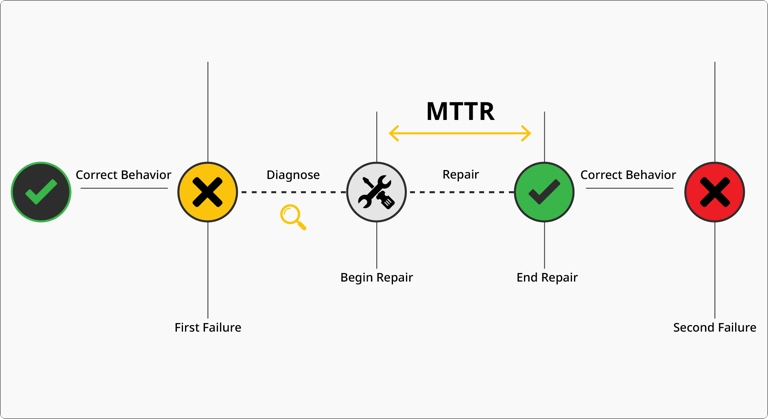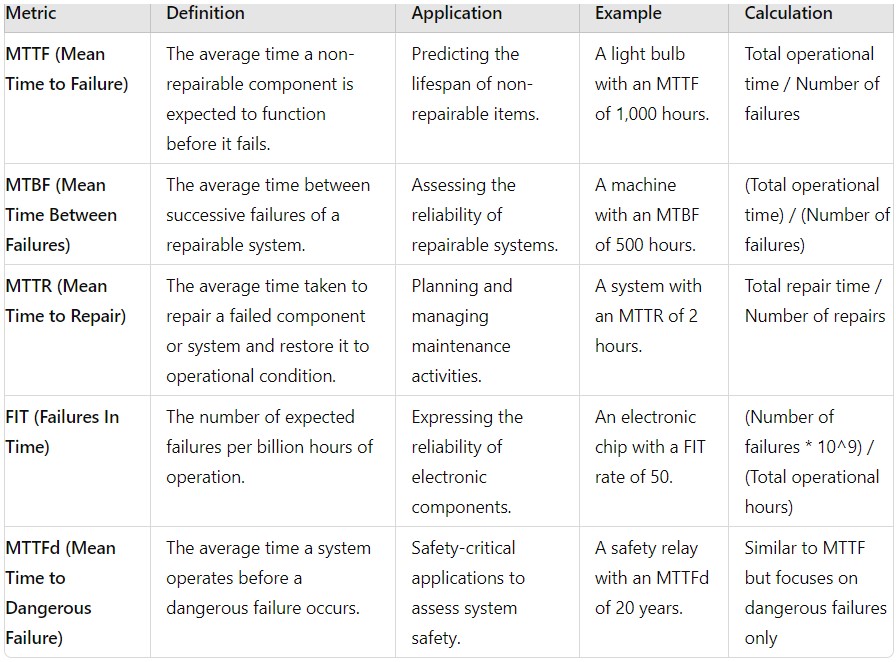 What is Mean Time to Repair (MTTR)?
What is Mean Time to Repair (MTTR)?
Mean Time to Repair (MTTR): MTTR, also known as Mean Time to Recovery, measures the average time required to repair a failed system or equipment. This metric starts from the moment a failure occurs until the system or equipment is fully operational again, including diagnosis, repair, and testing phases.
MTTR calculates the average time it takes to repair a specific asset and bring it back into operation after an unexpected breakdown. Usually expressed in hours, MTTR refers to the average length of time between an asset’s failure and its return to normal operation.
MTTR is a critical metric in maintenance management because it directly impacts operational efficiency and productivity. A lower MTTR indicates a more efficient repair process, minimizing downtime and maintaining continuity in operations. Organizations often strive to reduce MTTR through various strategies such as improving diagnostic procedures, ensuring the availability of spare parts, and enhancing the skills of maintenance personnel.
 Advanced technologies like predictive maintenance and real-time monitoring systems can also contribute to lowering MTTR by allowing maintenance teams to quickly identify and address issues before they escalate. Additionally, streamlined communication and effective coordination among different teams involved in the repair process play a vital role in reducing MTTR. Tracking and analyzing MTTR over time helps organizations identify bottlenecks in their maintenance processes and implement continuous improvements. This metric not only helps in optimizing maintenance practices but also in planning and allocating resources more effectively.
Advanced technologies like predictive maintenance and real-time monitoring systems can also contribute to lowering MTTR by allowing maintenance teams to quickly identify and address issues before they escalate. Additionally, streamlined communication and effective coordination among different teams involved in the repair process play a vital role in reducing MTTR. Tracking and analyzing MTTR over time helps organizations identify bottlenecks in their maintenance processes and implement continuous improvements. This metric not only helps in optimizing maintenance practices but also in planning and allocating resources more effectively.
In industries where downtime can lead to significant financial losses, such as manufacturing, aerospace, and telecommunications, maintaining a low MTTR is essential for sustaining operational performance and competitiveness. Therefore, MTTR serves as a key performance indicator (KPI) for maintenance efficiency and overall operational reliability, guiding efforts to enhance the maintenance strategy and ensure swift recovery from unexpected equipment failures.
How to Calculate MTTR
Finding the MTTR is a fairly simple process, but it requires some knowledge about an asset’s performance history, including the total amount of time spent on unplanned maintenance tasks as well as the number of incidents the machine has experienced during a given period of time.
An effective MTTR calculation measures the total amount of time it takes to for the team to identify a problem, diagnose the issue, complete the repair, reassemble and calibrate the asset, and finally restart and test the equipment.
To calculate MTTR, divide the total number of hours an asset is offline for unplanned maintenance — from the moment of failure until the asset is completely restored — by the total number of repairs done during a predetermined period of time. This calculation can be expressed with a simple formula:
Total Maintenance Downtime ÷ Number of Repairs = MTTR
A low MTTR means that the asset can be easily repaired and promptly returned to service, resulting in little if any effect on operations. Meanwhile, a higher MTTR score indicates a major impact, usually resulting in costly downtime of one or more systems.
Maintenance and reliability experts agree that an ideal MTTR is around five hours, but this varies by asset type. The end goal is to find and reduce high MTTR scores and improve the efficiency of repairs.
Why is MTTR Important?
MTTR is a valuable metric to help you maximize the efficiency of your maintenance operations. MTTR helps answer questions like:
Should an asset be repaired or replaced?
If the average repair process takes an exorbitant amount of time, it may be easier and more cost-effective to replace the asset instead.
When should preventive maintenance be performed?
MTTR can provide insight into the optimal timing for preventive maintenance to maximize an asset’s lifespan and avoid unexpected failures.
What is slowing down repair times?
MTTR can help you identify and resolve bottlenecks in your maintenance operations. For example, a disorganized parts inventory management process can significantly increase the time it takes to get a machine back up and running.
Benefits of Measuring MTTR
Measuring Mean Time to Repair (MTTR) offers several significant benefits that enhance maintenance efficiency and operational performance. Firstly, MTTR provides a clear understanding of how long it takes to restore equipment to full functionality after a failure, enabling organizations to identify inefficiencies in their repair processes. By analyzing MTTR, businesses can pinpoint areas for improvement, such as enhancing diagnostic procedures or ensuring quicker access to spare parts. Reducing MTTR leads to minimized downtime, which is crucial for maintaining productivity and meeting production schedules.
Additionally, a lower MTTR contributes to increased asset availability and reliability, directly impacting the overall equipment effectiveness (OEE). This metric also helps in resource planning, as it provides insights into the time and personnel required for repairs, aiding in better scheduling and allocation of maintenance tasks. Furthermore, tracking MTTR over time allows organizations to measure the effectiveness of their maintenance strategies and make data-driven decisions to optimize their processes. By focusing on reducing MTTR, companies can improve customer satisfaction by ensuring timely delivery and reducing the impact of equipment failures on production. Ultimately, MTTR is a valuable metric that supports continuous improvement in maintenance practices and operational efficiency.
How to Improve MTTR
Reducing MTTR requires deep analysis of failures, close monitoring of asset condition, and a planned schedule of preventive maintenance tasks.
Condition Monitoring
As Internet of Things (IoT) technology has evolved and become more accessible, many manufacturing plants have begun to adopt condition monitoring programs to both monitor equipment condition in real time and track asset performance over time. Smart sensors continuously monitor conditions like temperature and vibration that are often the first indication of machine failure.
Condition monitoring provides valuable insight into baseline system performance and can alert maintenance staff when conditions exceed a predefined threshold for normal/optimal operation. This allows maintenance personnel to address and repair smaller issues (for example, replacing a worn bearing) before it leads to failure and unplanned downtime. By enabling minor maintenance problems to be resolved before they escalate to total failure, condition monitoring can significantly reduce an asset’s MTTR.
Predictive Maintenance
The insights gained from condition monitoring unlock the ability to perform predictive maintenance on your equipment. Predictive maintenance is different from scheduled preventative maintenance because it uses data from your machines themselves to predict when failures may occur and help prevent them from happening in the first place. These data-driven insights allow you to continuously improve your MTTR scores, ultimately time and costs while maximizing production uptime.
What is the Difference between MTTR, MTBF, MTTF, MTTFd, and FIT?
MTTR is just one measure of asset performance. Other performance metrics include Mean Time Between Failures (MTBF), which indicates an asset’s overall reliability by measuring the average amount of time between incidents; and Mean Time to Failure (MTTF) which is used to determine the average lifespan of assets that cannot be repaired.
Together, these maintenance KPIs help you determine the overall effectiveness of your maintenance team when responding to equipment performance issues. Use MTBF, MTTR, and MTTF together for a comprehensive look at each asset.

To learn more, see the 7 Most Important Maintenance Metrics.
Common Challenges When Measuring & Tracking MTTR
Inconsistent Recording of Repair Times: One common challenge is the inconsistent recording of repair times. Without standardized procedures for documenting the start and end times of repairs, the data collected can be unreliable.
Variations in Repair Complexity: Variations in the complexity of repairs can skew MTTR calculations. For instance, a simple fix might take significantly less time than a complex repair, making it challenging to derive a meaningful average.
Lack of Integrated Systems: Many organizations still rely on manual processes or disparate systems, leading to data fragmentation and inaccuracies. Ensuring that all maintenance personnel are trained and follow the same procedures for reporting repairs is crucial.
External Factors: Delays in receiving spare parts or the availability of specialized technicians can impact repair times but are often beyond the control of the maintenance team.
Overlooked Downtime: Potential downtime that is not directly related to the repair process, such as waiting for equipment to cool down or safety inspections, can affect the overall MTTR calculation.
Addressing these challenges requires a combination of standardized procedures, effective training, integrated maintenance management systems, and continuous monitoring and analysis to ensure accurate and actionable MTTR data.
How is MTTR Used: Common Applications
- Manufacturing: MTTR is crucial for minimizing production downtime and ensuring continuous operation. By analyzing MTTR, manufacturers can identify bottlenecks in their repair processes and implement improvements to reduce downtime.
- IT Industry: MTTR measures the efficiency of incident response and resolution times for hardware and software failures. Quick recovery times are essential for maintaining service levels and minimizing the impact on business operations.
- Telecommunications: MTTR ensures network reliability and service availability. By tracking MTTR, telecom companies can optimize their maintenance schedules and improve customer satisfaction by reducing service interruptions.
- Healthcare: MTTR is critical for maintaining the availability of medical equipment and ensuring patient safety. Hospitals use MTTR to manage the repair of critical devices such as MRI machines and ventilators, ensuring they are operational when needed.
- Energy Sector: MTTR enhances the reliability of power generation and distribution systems. By minimizing repair times, energy companies can ensure a stable power supply and reduce the risk of outages.
How Failure Metrics Improve your Maintenance and Reliability Program
Maintenance and reliability organizations are defined by the reliability of their assets, and every plant’s goal should be minimizing equipment downtime. Asset failure has a direct effect on the company’s bottom line, as unexpected maintenance can cause production delays and unplanned expenses.
Mean Time to Repair (MTTR) is a maintenance metric that helps teams understand how efficiently they resolve unplanned maintenance issues, as well as identify and resolve bottlenecks in their processes. Reducing MTTR is key to improving a plant’s efficiency. A computerized maintenance management system (CMMS) software can help track MTTR and other common maintenance key performance indicators.

